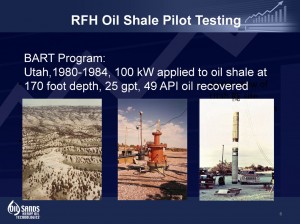Oil and Gas Extraction from Kerogen in Oil Shale

The economic and technical viability of JRT’s oil recovery technology using radiofrequency energy was demonstrated in the early 80’s with oil shale; it was intensively tested in a four-year, multi-million dollar commercial scale, pilot program on Texaco oil shale property outside Vernal, Utah. It was a Badger, Raytheon, and Texaco joint venture, known as the “BART Program.” This program was technically overseen by Ray Kasevich while he was Technical Director of BART at Raytheon. He provided several key RF patents for this program. The program demonstrated:
- Energy efficiency. It demonstrated a nearly 5 to 1 energy returned on energy invested (EROI) ratio. This is superior to the EROIs of many of the alternative technologies currently being applied to tight sources of oil and gas.
- High product quality potential. Very high quality, low sulfur content oil was extracted which was similar to high quality Arabian crude without any significant added refining.
- Technological scalability. The Utah project employed a full scale commercial design. Radio frequency antennas were positioned in boreholes at shale depths of up to 200 feet with commercial radio frequency generators transmitting 50,000 watts of energy or less to the downhole antenna to demonstrate and achieve optimum oil recovery temperature at 350 degrees Celsius. Gas production (methane) was continuously produced and quantified during the oil recovery period.
